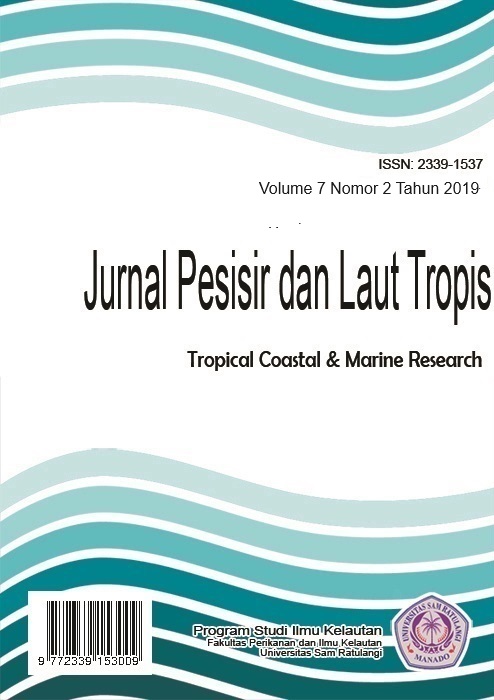PEMISAHAN JENIS PIGMEN KAROTENOID DARI KEPITING Grapsus sp JANTAN MENGGUNAKAN METODE KROMATOGRAFI KOLOM
DOI:
https://doi.org/10.35800/jplt.7.2.2019.24247Abstract
Grapsus sp crab has a greenish black body color and also known as stone crab. Crabs in the genus Grapsus sp have a swift movement, long legs, they do not have swimming legs and have small reddish purple or purple-orange color, claws on the body of this crab indicated the presence of pigments such as carotenoid pigments. Carotenoid pigments are one form of secondary metabolites which consist of carotene and xanthophyll groups. Carotenoid pigments are present in yellow, orange or orange red which are also found in crabs. Separation of carotenoid pigments can be done using the TLC method, High Performance Liquid Chromatography (HPLC) and Column Chromatography (CC). The purpose of this study was to determine the type of carotenoid pigment from male Grapsus sp crab extract using the Column Chromatography separation method. From the results of this study, the carotenoid pigment content in the 1,2 and 3 carapace was 46,85 μg, 39 µg, and 33,14 µg. The carotenoid pigment concentrations in carapace extracts 1,2 and 3 are 25,38 µg/g, 23,4 µg/g and 5,11 µg/g. From the results of the separation using the column chromatography method, the type of carotenoid pigment identified from the carapace extract of Grapsus sp male is β-Carotene, Ekinenon, Astaxantine, Kantaxantine and Astacen.
Keywords: Grapsus sp, Carotenoid, Column Chromatography
Kepiting Grapsus sp memiliki warna tubuh hitam kehijauan dan dikenal dengan nama kepiting batu. Kepiting dalam genus Grapsus sp memiliki gerakkan yang cekatan, mempunyai kaki yang panjang, tidak memiliki kaki renang dan memiliki capit berukuran kecil yang berwarna ungu kemerahan atau ungu-oranye warna pada tubuh kepiting ini mengindikasikan adanya kandungan pigmen seperti pigmen karotenoid. Pigmen karotenoid merupakan salah satu bentuk metabolit sekunder yang yang terdiri dari golongan karoten dan xantofil. Pigmen karotenoid hadir dalam warna kuning, oranye, atau merah oranye, yang juga ditemukan pada kepiting. Pemisahan pigmen karotenoid dapat dilakukan dengan menggunakan metode KLT, Kromatografi Cair Kinerja Tinggi (KCKT) dan Kromatografi Kolom (KK). Tujuan dari penelitian ini adalah untuk mengetahui jenis pigmen karotenoid dari ekstrak kepiting Grapsus sp Jantan dengan menggunakan metode pemisahan Kromatografi Kolom. Dari hasil penelitian ini, didapatkan kandungan pigmen karotenoid pada karapas 1,2 dan 3 adalah 46,85 µg 39 µg, dan 33,14 µg. Konsentrasi pigmen karotenoid pada ekstrak karapas 1,2 dan 3 adalah 25,38 µg/g, 23,4 µg/g dan 5,11 µg/g. Hasil pemisahan menggunakan metode pemisahan kromatografi kolom didapatkan ekstrak karapas kepiting Grapsus sp jantan memiliki jenis pigmen β-Karoten, Ekinenon, Astaxantin, Kantaxantin dan Astasen.
Kata kunci: Grapsus sp, Karotenoid, Kromatografi Kolom,Â
















